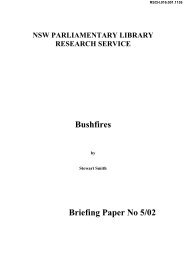Chapter 4 - Warnings - 2009 Victorian Bushfires Royal Commission
Chapter 4 - Warnings - 2009 Victorian Bushfires Royal Commission
Chapter 4 - Warnings - 2009 Victorian Bushfires Royal Commission
Create successful ePaper yourself
Turn your PDF publications into a flip-book with our unique Google optimized e-Paper software.
<strong>2009</strong> <strong>Victorian</strong> <strong>Bushfires</strong> <strong>Royal</strong> <strong>Commission</strong>—Interim Report<br />
4 WARNINGS<br />
2005 Catastrophic Disasters Report<br />
4.31 In October 2005 the report, Catastrophic Disasters Emergency Management Capability Working Group —<br />
Review of Australia’s Ability to Respond to and Recover from Catastrophic Disasters was prepared by the<br />
Catastrophic Disasters Emergency Management Capability Working Group, chaired by Mr Tony Pearce,<br />
then Director of Emergency Management and Security of the Office of the Emergency Services <strong>Commission</strong>er<br />
(OESC) in Victoria. 22<br />
4.32<br />
4.33<br />
4.34<br />
The 2002 COAG report had recommended the creation of the Working Group that then prepared the<br />
2005 report. It found that ‘whilst existing State/Territory and national emergency management arrangements<br />
are robust … Australia is currently not as prepared as it should be to manage the consequences of a<br />
catastrophic disaster impacting the country’. 23<br />
The Working Group modelled four hypothetical scenarios to assist in identifying the likely impact of<br />
catastrophic events: a cyclone impacting on Cairns, a major earthquake impacting the wheat-belt of<br />
Western Australia and the City of Perth, a tsunami impacting on the mid New South Wales coast and<br />
an influenza pandemic. 24 The report found that ‘there is an overwhelming national need for the development<br />
of appropriate, effective and timely community information and warning systems’. It also emphasised<br />
the desirability of a national approach, and the potentially counter-productive consequences of disparate<br />
systems being developed in isolation. 25<br />
It is disappointing that what was identified in October 2005 as an ‘overwhelming national need’ for a<br />
national warning system, was not the subject of agreement by the states and territories until April <strong>2009</strong>.<br />
It is also a matter of concern that the 2005 Catastrophic Disasters report, which revealed significant<br />
areas for improvement in Australia’s capacity to respond to natural disasters, was not made public until<br />
summonsed and tendered in the <strong>Commission</strong>’s hearings. 26 One of the clear lessons from the fires of<br />
7 February and from the substantial body of material on natural disaster and warning systems generally,<br />
is that the community, governments and emergency services benefit from the free flow of information.<br />
The decision not to release this important report for a number of years did nothing to increase community<br />
preparedness to meet the challenges posed by natural disasters.<br />
2006 Fire agencies’ internal review<br />
4.35 In 2006, the CFA and the Department of Sustainability and Environment (DSE) commissioned Mr John<br />
Schauble to conduct a review of information processes during fire incidents, including the issue of provision<br />
of warnings to the community during fires: Joint CFA/DSE Review of Effectiveness of Information Flow to<br />
Communities and Media During Fire Incidents — Preliminary Findings. 27<br />
4.36<br />
This review involved a series of debriefs and interviews with CFA and DSE personnel engaged in<br />
the information management process. It focused on the work of the Information Units in Information<br />
Management Teams in the fire services. The report noted:<br />
… the bar has been raised’ in terms of both how rapidly information about developing events is released<br />
to the general community and how specific that information should be. It is no longer sufficient to report<br />
that a large fire is burning in a general location. There is now an expectation on the community’s part that<br />
timely and useful information regarding predicted spread into specific locations, including particular streets,<br />
will be made available in time for potential-affected citizens to make decisions. 28<br />
WHAT MAKES A GOOD BUSHFIRE WARNING?<br />
124<br />
4.37<br />
The <strong>Commission</strong> received expert advice on what constitutes an effective warning in written submissions<br />
and in oral evidence. 29 Other key documents on this topic include:<br />
■■<br />
2005 and <strong>2009</strong> Australasian Fire and Emergency Service Authorities Council (AFAC) position papers<br />
■■<br />
2008 Australian Government advice Emergency <strong>Warnings</strong> — Choosing your Words 31<br />
■■<br />
Material relating to the Common Alerting Protocol (CAP).<br />
32<br />
30
















